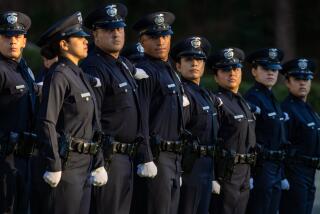Negotiators Often End Up in the Middle
- Share via
In the movies, hostage negotiators are almost always the mavericks of their police departments, shown like this: A madman holds an Uzi to a whimpering woman’s temple as the heroic negotiator, disobeying his commanding officer, strides through the police line, dangles his revolver between his thumb and forefinger and drops it like a dirty diaper.
Then, with brazen courage, he swaggers into the lion’s den announcing “I’m not armed.”
“We just hate that,” said Los Angeles Police Sgt. Andy Lamprey, who does in real life what actors such as Clint Eastwood, Mel Gibson and Eddie Murphy do on the screen.
“We almost never, never go into a situation like that. The most desired position is to never go face-to-face.
“And even when we do go in, we never go in unarmed,” he said.
Of the 78 situations involving hostages and barricaded suspects reported in Los Angeles last year, more than half were resolved with the help of crisis negotiators from the LAPD’s Special Weapons Assault Team. Members of the elite unit are also on call 24 hours a day to try to dissuade people threatening suicide.
Lamprey, one of six supervisors of the unit, called crisis negotiation a “blending of verbal and physical tactics.”
“Crisis negotiators have to have a clear understanding of the physical tactics involved in such situations,” said Lamprey. “Often the negotiator will induce the suspect into a position that will help us take them into custody.” Negotiators also may help assault teams by finding out where and how well-armed a suspect is, Lamprey said.
Negotiators must be able to process information quickly and stay cool under pressure. Excellent verbal skills are necessary, but even more important is the ability to listen.
“Anybody can talk--that’s the small part,” Lamprey said. “The larger part is to listen and understand what the bad guy or the suicidal guy is trying to convey.
“Crisis negotiators must be good listeners who have empathy and compassion toward other human beings,” Lamprey said, “and at the same time are able to make hard critical assessments of the people they’re dealing with.”
Crisis negotiators must first establish contact with the suspect so they can begin to develop a picture of the situation inside a commandeered building, hijacked vehicle or barricaded home. They interview relatives and friends to put together a psychological profile, and check criminal records to determine if the suspect has a propensity for violence.
“Usually they want something; we want to know what their desires are,” said Lamprey. “Some demands we’ll never [meet], some we can . . . what we’re trying to do is strike a bargain with them so that they will release the hostages.” Common demands include making a public statement or obtaining money, getaway vehicles or food, Lamprey said.
Often negotiators spend hours building rapport with a hostage taker, Lamprey said. Statistics show that the likelihood of a peaceful resolution increases as time goes by. But as negotiators work to establish trust with hostage takers, they risk becoming personally affected.
“It is a very easy thing to get emotionally attached to the hostage taker,” Lamprey said. “Even the most skilled negotiator can get tunnel vision and feel very responsible for the person they’ve been negotiating with. It’s human nature.”
More to Read
Sign up for Essential California
The most important California stories and recommendations in your inbox every morning.
You may occasionally receive promotional content from the Los Angeles Times.













